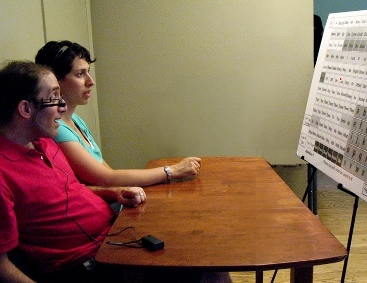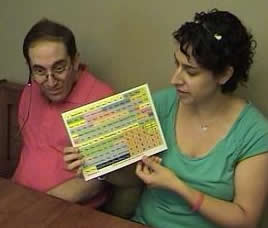Why Use Low Tech?
Low Tech For Reasons of Location/Situation.
There are certain locations/situations where it might not be feasible to use a high tech system.
Some examples:
- While in the shower, or using the bathroom
- Riding in the car
- On the beach
- Making a quick request in the middle of the night
- Needing to communicate while temporarily in the hospital

When Jason is at home, he uses an eye gaze computer, and a large communication board and laser.

When Jason is out in the community he uses a small communication board and laser.
Examples of People Using Low Tech for Reasons of Location/Situation:
click on green BARS below to open and close
(To open using keyboard commands, tab down to highlight the green bar, then hit "down arrow" key)
Doug has ALS. He has very little movement below his neck. During the day, Doug uses a special head operated mouse to access his communication device. He uses his communication device to communicate out loud, to write emails, to work on his blog and write his book. He is not able to use his head mouse while he is in bed. (He needs his head supported in a headrest in order to use the head mouse.)
Doug’s wife, Ronnie, is helping him getting ready for bed. She takes the communication device off of his wheelchair, and uses a special lift to get him into bed. Doug is tucked in and comfy, when all of a sudden he yelps - something is clearly wrong.
Theoretically, Ronnie could….
- Put Doug back in his wheelchair
- Put the communication device back on the chair
- Turn the communication device on, and allow it to power up
Ronnie could do all of this, but it would take about 15 minutes. Instead, Ronnie takes intelligent guesses.
She asks: “Are you in pain?” – Doug nods “no”.
“Does it have to do with your body?” – Doug nods "yes".
“Is it your positioning? – No.
“Is it your arms?”- No.
Doug looks down at his legs.
“Is it your legs?”- Yes.
Robie peels back the blanket and looks at Doug’s legs.
“Are you having a cramp?” – No.
Doug blinks two hard blinks, which is a signal that he and Ronnie have developed which means: –
“Let’s stop guessing and try spelling it out”
Ronnie starts verbally scanning through the sections of the alphabet, using a strategy called partner assisted auditory scanning. Within 15 seconds, Doug has spelled out the word “bug”. Ronnie pulls up one Doug’s pajama legs, and sure enough, there is a lady bug crawling up Doug’s leg, under his pajama bottoms.
In this one situation, Doug and Ronnie used a number of different low tech strategies-
-
VOCALIZATION:
Doug vocalized, to let Ronnie know that something was wrong. -
INTELLIGENT GUESSING:
Ronnie made some intelligent guesses, based on Doug's frequently requested needs. -
EYE GAZE:
Doug used eye gaze (looking at his leg) to indicate where he needs help. -
GESTURE:
Doug used a gesture to indicate that he wanted to switch from guessing to spelling. -
PARTNER ASSISTED AUDITORY SCANNING
Doug and Ronnie used a system to spell out the word he was trying to say.
The whole process took less than a minute.
Gilberto and Estrella have a wheelchair accessible van. When Gilberto is at home, he communicates by using a eye gaze communication device. However, it’s not feasible for him to use this system when they are driving in the van.
When they use the van, Gilberto’s wheelchair is positioned next to the driver’s seat.
When Gilberto needs to say something, he vocalizes (makes a sound with his mouth). His left hand is positioned on his lap, palm down and with his fingers curled. Estrella slides the index finger of her right hand into his fist, and Gilberto squeezes her finger. (Estrella makes sure to keep her eyes on the road while they are communicating.)
Some strategies that Gilberto and Estrella have come up with:
Yes/No
Gilberto squeezes Estrella’s finger one time for yes, and two times for no.
Directions
Gilberto pushes Estrella’s hand to the left to indicate- “Turn left” and pulls it to the right to indicate- “Turn right”.
Spelling
Estrella uses partner assisted auditory scanning if Gilberto needs to spell something. (For the most part, Gilberto and Estrella don’t have long conversations while driving in the van, they might just spell out a single word or two.)
Estrella calls out the letters of the alphabet in groups- Starting with AEIOU. When she gets to the row that has the letter he wants, he squeezes her finger. Let’s say he squeezes her finger when she calls out the “I” row. Estrella will then call out the letters in that row “I, J, K, L….” Gilberto squeezes her finger when she calls out the letter he wants.
Jenna is 14 and has cerebral palsy. She communicates very effectively with her speech generating device during the day.
During bathtime, Jenna uses a few different low tech strategies to communicate:
NEEDS BOARD:
Jenna has a laminated sheet which is taped to the wall above the bathtub. It contains a few phrases that she only uses during bathtime, for example:
-
Add hot water
-
Wipe eyes
-
Scrub in between toes
-
Turn on heater
-
Change Music
-
Beatles
-
Beyonce (etc.)
(Jenna is a big music buff).
Jenna will indicate that she wants something by looking at the laminated list. Her communication partner will call out the items by number:
"1? 2? 3? 4?"
Jenna will nod when the number for the desired item is called out.
PARTNER ASSISTED SCANNING
Infrequently, Jenna will want to say something that isn't on her bath-time needs board. She will spell out a word using partner assisted auditory scanning. She usually uses this just to spell a single word.(Generally, her communication partner can figure out what she is spelling after just a few letters.)
YES/NO:
Jenna often chats with her caregiver during bathtime by answering yes/no questions.
Connie has ALS… She is going to be in the hospital for 2 days for a gastrointestinal problem.
Connie has to be properly positioned and set up in order to use her head mouse and speech generating device…She decides to leave her speech generating device at home, and use her laser pointer and board while in the hospital. (At this particular facility, tt seems like it might not be feasible for the nursing staff to get her set up.)
Connie is also worried about something happening to her device at the hospital. She decides to keep it simple, and just take her communication board and laser with her for her hospital stay. Her friend shows the nursing staff how to adjust the laser, and how to turn it on and off.

